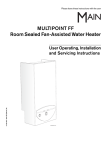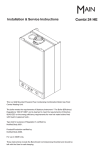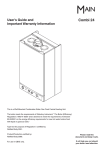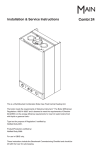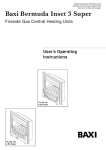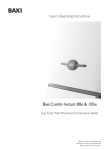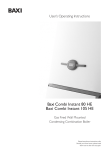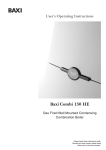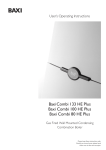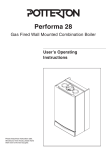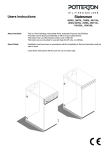Download Baxi 956 Operating instructions
Transcript
Please leave these instructions with the user MULTIPOINT BF Gas Fired Balanced Flue Water Heater 6 720 607 090 (03.12) JS User Operating, Installation and Servicing Instructions Natural Gas Main Multipoint BF G.C. No 52-467-01 This appliance conforms to European Standard EN 26. Type test for purpose certified by Notified Body CE-0087. Product/Production certified by Notified Body CE-0464. For GB / IE only. Care must be taken when lifting and handling this appliance, seek assistance where appropriate. Protective equipement (e.g. gloves) should be worn as necessary. User Information Your Main Multipoint BF is designed to meet all relevant standards. Main provide a 12 month guarantee on the appliance. The guarantee operates from the date installation is completed for the customer who is the original owner. Any component or part which becomes defective during the guarantee period as a result of faulty workmanship or materials whilst in normal use will be repaired or replaced free of charge. 2 6 720 607 090 Contents Section 1. 2. 3. 4. 5. 6. 7. 8. 9. 10. 11. 12. 13. 14. 15. 16. 6 720 607 090 page User’s Operating Instructions ..................................... 4 General Layout .............................................................. 5 Technical Data ............................................................... 6 Dimensions and Fixings ................................................ 7 General Information ...................................................... 8 Installation Regulations ................................................ 8 Siting the Appliance ..................................................... 9 Siting the Flue Terminal ............................................ 10 Air Supply ..................................................................... 11 Gas Supply .................................................................. 11 Installation .................................................................... 11 Commissioning ............................................................ 13 Inspection and Servicing .......................................... 14 Replacement of Parts ................................................ 16 Fault Finding ................................................................ 18 Short Parts List ........................................................... 18 3 1. User’s Operating Instructions Pilot ignition: 1. Depress slide control and hold it in. - Off 2. Press the igniter repeatedly until the pilot is alight. - Pilot - Burner - Igniter 3. Release the slide control approx 10 seconds after pilot lights. 4. Repeat these steps if the pilot does not remain alight. Burner operation: When the slide control is in the “burner” position the burner will ignite when a hot tap is turned on. Temperature regulation: Turn left to reduce water temperature Turn right to increase water temperature Note: with higher temperatures the available flow of water will be reduced. Switching off: Move slide control to the far left Note: the pilot flame will extinguish Note: if the appliance is to be left unused in an unheated area during cold weather the gas and water supplies should be isolated and the system drained. Your installer will be able to advise you. 4 6 720 607 090 2. General Layout Appliance components 1 2 3 4 5 6 7a 7b 8 9 10 11 12 13 14 15 16 17 18 19 20 21 22 23 24 25 26 27 28 29 30 31 32 Fig. 3 Appliance water flow diagram. Pilot burner Spark electrode Thermocouple Heat exchanger Main burner Burner injector Burner pressure test point Inlet gas pressure test point Gas setting screw Pilot gas filter Pilot gas valve Electromagnetic valve Gas filter Slow ignition valve Venturi Gas inlet pipe Correcting screw for minimum water flow Temperature control Drain cock Volumetric water governor Cold water pipe (inlet) Hot water pipe (outlet) Water filter Diaphragm Piezo igniter Slide control Pilot gas button Gas valve Main gas valve Pilot gas pipe Temperature limiter Flue hood Water valve Fig. 4 6 720 607 090 5 3. Technical Data TABLE 1 - GENERAL Natural Gas I2H C11 7 kW 23 kW 25.5 kW Gas category Appliance Type Minimum rated output Maximum rated output Rated input (Net) 3 Gas rate (CV 34 MJ/m ) Inlet pressure Number of injectors Injector diameter Pilot injector marking Burner pressure Height Width Depth Dry weight Gas connection Hot/cold water connections 3 2.9 m /hr 20 mbar 16 1.05 mm 104 14.1 mbar 846 mm 420 mm 285 mm 20 kg 15mm Copper 15mm Copper TABLE 2 - FLUE DETAILS Wall hole size - width Wall hole size - height Sales Code 31/10321 Sales Code 31/10322 Sales Code 31/10323 Sales Code 31/10324 min. length max. length min. length max. length min. length max. length min. length max. length 310 mm 300 mm 100 mm (4 in.) 150 mm (6 in.) 150 mm (6 in.) 230 mm (9 in.) 230 mm (9 in.) 380 mm (15 in.) 380 mm (15 in.) 610 mm (24 in.) TABLE 3 - PERFORMANCE Maximum cold water supply inlet pressure 12 bar (180 p.s.i.) Minimum cold water supply inlet pressure to operate the appliance 0.2 bar (2.9 p.s.i.) Minimum cold water supply inlet pressure for maximum domestic hot water flow Domestic hot water delivery with temperature control knob fully anticlockwise Domestic hot water delivery with temperature control knob fully clockwise 1 bar (15 p.s.i.) 4 to 13 litres/minute at 25°C temperature rise 2.5 to 6 litres/minute at 55°C temperature rise The appliance has a permanent pilot. The appliance and flue components are packed in separate cartons. The appliance is for use with Natural Gas only. 6 6 720 607 090 4. Dimensions and Fixings Fig. 5 6 720 607 090 7 5. General Information 6. Installation Regulations 5.1 GENERAL INSTALLATION If the appliance is to be fitted into a compartment, the compartment must conform to the requirements of BS 6798. Do not place anything on top of the appliance. The clearances specified for servicing must be maintained. 6.1 Warning - Check the information on the data plate is compatible with local conditions. 5.2 SHOWERS If a shower control is supplied from the appliance it should be of the thermostatic or pressure balanced type. Thermostatic type shower valves provide the best comfort and guard against water at too high temperature. Existing controls may not be suitable - refer to the shower valve manufacturer. The installation must be carried out by a CORGI Registered Installer or other registered competent person and be in accordance with the relevant requirements of the current Gas Safety (Installation and Use) Regulations, the building regulations (Scotland) (Consolidation), the local building regulations, the current I.E.E Wiring Regulations and by the laws of the local water undertaking. Where no specific instruction is given, reference should be made to the relevant British Standard Code of Practice. For Ireland, install in accordance with IS 813 “Installation of Gas Appliances”. 6.2 B.S Codes of Practice Standard Scope BS 6891 Gas Installation BS 5546 Installation of water supplies for domestic purposes BS 6798 Installation of gas fired hot water boilers BS 5440 Part1 Flues BS 5440 Part2 Ventilation WARNING - The addition of anything that may interfere with the normal operation of the appliance without the express written permission of Baxi Potterton could invalidate the appliance warranty and infringe the Gas Safety (Installation and Use) Regulations. 8 6 720 607 090 7. Siting the Appliance 7.1 The appliance is NOT suitable for external installation. 7.2 The appliance is NOT suitable for SE DU CT application. 7.3 The appliance is suitable for replacement onto four stud flue terminals as shown (check dimensions on page 7). The following Appliance Models will have a compatible flue terminal: Severn4/5, Avon, Trent, Thames, Medina/DL, Medway, Bristol and Mersey. It is advisable to examine the condition of the flue and replace if necessary. 7.4 If the appliance is to be fixed to a suitable existing flue terminal (four mounting studs) first isolate and remove the old appliance. Leave the flue terminal in place. Make good any damage to the brickwork or plaster around the terminal. Cut off the existing pipework at a convenient point below the appliance. Fig. 6 7.5 The appliance does not require any special wall protection. 7.6 The wall must be capable of supporting the weight of the appliance. See Technical Data – Table 1. 7.7 If the appliance is to be fitted in a timber framed building, refer to the Institute of Gas Engineers, “Guide for gas installations in timber framed housing” IGE/UP/7. 7.8 The minimum clearances required for Installation and Servicing: Above In front Below Right hand side Left hand side 30 mm 600 mm 75 mm 5 mm 5 mm 7.9 The minimum clearances required for Operation are: Above 30 mm In front 60 mm Below 75 mm 5 mm Right hand side Left hand side 5 mm 7.10 The appliance can be installed in a cupboard used for airing clothes provided that requirements of BS 6798 and BS 5440:2 are strictly followed. See section 9 for further detail. 7.11 The airing space must be separated from the appliance space by a perforated non-combustible partition. Expanded metal or rigid wire mesh are acceptable provided that the major dimension is less than 13 mm. See BS 6798. 6 720 607 090 9 8. Siting the Flue Terminal See Fig. 8. 8.1 The flue must be installed as specified in BS 5440:Part 1. 8.2 If the terminal discharges onto a pathway or passageway, check that the combustion products will not cause a nuisance and that the terminal will not cause an obstruction. 8.3 If the terminal is fitted within 850 mm of a plastic or painted gutter or within 450 mm of painted eaves then an aluminium shield at least 750 mm long should be fitted to the underside of the gutter or painted surface. 8.4 If a terminal is fitted less than 2 metres above a surface to which persons have access then a guard must be fitted. 8.5 The terminal guard must be evenly spaced about the flue terminal and fixed to the wall using plated screws. Fig. 7 8.6 Under certain weather conditions the terminal may plume when the appliance is operated. Siting where this could cause a nuisance should be avoided. 8.7 Take care to ensure that combustion products do not enter ventilated roof voids by positioning the flue away from any soffit vents. Dimension Terminal position a A a B a C D E F G H I J K L M N 10 Directly below an opening, air brick, opening windows, etc. Above an opening, air brick, opening window, etc. Horizontally to an opening, air brick, opening window, etc. Below gutters, soil pipes or drain pipes Below eaves Below balconies or car port roof From a vertical drain pipe or soil pipe From an internal or external corner Above ground roof or balcony level From a surface facing the terminal From a terminal facing the terminal From an opening in the car port (e.g. door, window) into the dwelling Vertically from a terminal on the same wall Horizontally from a terminal on the same wall Minimum distance 1500 mm 300 mm 600 mm 300 mm 300 mm 600 mm 300 mm 600 mm 300 mm 600 mm 600 mm 1 200 mm 1 500 mm 300 mm Fig. 8 - Siting of the flue terminal 6 720 607 090 9. Air Supply 9.1 The appliance does not require a separate vent for combustion air. 9.2 The appliance may be installed in an unvented compartment. 9.3 There must be sufficient clearance around the appliance to allow proper circulation of air. The clearences required for operation will normally be adequate. 9.4 Refer to BS 6798 and BS5440:2 for additional information. 10. Gas Supply 10.1 The gas installation should be in accordance with BS 6891. 10.2 The connection to the appliance is 15mm compression via the gas isolation valve supplied. 10.3 Ensure that the pipework from the meter to the appliance is of adequate size. If the appliance gas rate cannot be achieved, the specified hot water conditions will not be reached. 11. Installation 11.1 FLUE INSTALLATION If an existing flue terminal is not being used, refer to the flue installation instructions on the wall template. 11.2 Unpack the appliance and take care to remove the installation kit which is packed on top of the polystyrene packing The installation kit consists of the following: Gas inlet: 1x Copper inlet elbow, Compression Nut, fibre washer 1x Isolation valve, 2 x Compression nuts and Olives Water Inlet: 1x Copper inlet elbow, Compression Nut, fibre washer 1x Isolation valve, 2 x Compression nuts and Olives Water Outlet: 1x Flanged Copper Pipe, Compression nut, Fibre washer 11.3 Lay the appliance on its back and unscrew the Temperature Control Knob Bezel. Fig. 9 6 720 607 090 11 11.4 Unfasten the two retaining screws and lift the case clear. 11.5 Remove the flue hood from the appliance by undoing the three fixing screws and lift the hood clear. 11.6 Place the appliance on its side, obtain the flue terminal sealing strip from the kit and fit into the recess around the flue aperture in the back of the appliance. (fig. 10). 11.7 Lift the appliance and locate onto the four flue terminal mounting studs. Secure in position using the four slotted nuts and washers provided. 11.8 Re-fit the flue hood making sure that the spigot of the collector hood enters the flue terminal duct. Tighten the three collector hood fixing screws. Fig. 10 Note: The whole of the gas installation should be inspected and tested for soundness and purged in accordance with the recommendations of BS 6891. 11.9 Make up the gas supply to the upper connection on the gas control assembly using the fibre washer provided. Fit the gas isolation valve as close as possible to the appliance (fig. 11, pos. 1). 11.10 Connect the appliance to the incoming cold water supply using the copper Inlet Elbow and Isolation Valve. A fibre washer is provided (fig. 11, pos. 2). 11.11 Connect the appliance to the domestic water remote draw off points via the outlet fitting. 11.12 Turn on the water supply to the appliance. Open the isolation valve on the inlet fitting to the appliance and then open the highest hot water tap in the installation until all air is removed from the system. Fig. 11 12 6 720 607 090 12. Commissioning Before commissioning the appliance, the gas installation must be purged and tested for gas soundness in accordance with BS 6891. Fig. 12 - Inlet pressure test point Fig. 13 - Gas control slide - Pilot ignition position Fig. 14 - Gas control slide - operating position Move slide control to the far left Fig. 15 - Gas control slide - shut down position Fig. 16 - Burner pressure test point 6 720 607 090 12.1 Ensure that the gas isolation valve in the gas inlet pipe is turned off. 12.2 Loosen screw A and connect a pressure gauge to the test point. (fig. 12). 12.3 Turn on the gas isolation valve, replace the Outer Case. 12.4 Move the gas control slide to the ignition position . (fig. 13). Depress slide control and hold it in. Press the igniter repeatedly until the pilot is alight. Release the slide control approx 10 seconds after pilot lights. Repeat these steps if the pilot does not remain alight. Note: On initial light up, or after prolonged shut down, the establishment of the pilot may take several attempts due to the presence of air in the gas supply pipe. The pilot flame should envelope approximately 5 mm of the thermocouple head. 12.5 Once pilot is established, move slide control to burner operation position . Fully open any hot water tap. The main burner should light. 12.6 Check the dynamic inlet gas pressure is 20 mbar. If the pressure is not correct then check the gas supply to the appliance. If the pressure is correct, turn off the hot water tap and move the slide to the off position. (fig. 15). Remove the outer Case, turn off the Gas Isolation Valve. Remove the pressure gauge and tighten screw A. (fig. 12). 12.7 The burner pressure is factory set and should not require adjustment, confirmation of burner pressure can be made as below. Loosen screw D and connect the pressure gauge to the test point (fig. 16). Replace the Outer Case. Re-light the appliance as described in paragraph 12.4 and 12.5. 12.8 Operate the appliance for at least 2 minutes then check that the burner pressure is 14.1 mbar. 12.9 Turn off the hot water tap. remove the Outer Case. Close the gas service cock. Remove the pressure gauge and tighten screw D. Replace the Outer Case. 12.10 On completion of the commissioning and testing of the system, the installer should: 12.10.1 Give the Instructions to the user for safe keeping. 12.10.2 Explain and demonstrate the lighting and shutdown procedures. 12.10.3 Advise the user of the precautions necessary to prevent damage to the system and to the building in the event of the system remaining inoperative during frost conditions. 12.10.4 Recommend that the appliance is serviced annually for reasons of safety and economy and that the servicing must be carried out by a competent person. 13 13. Inspection and Servicing For reasons of safety and economy it is recommend that the appliance is serviced annually. The servicing must be carried out by a competent person. Before commencing any service operation turn off the gas supply at the main gas service cock. Ensure that the appliance is cool. Access for Servicing Pull off the fascia and undo the two fixing screws. Pull off the Temperature Control Knob. Unscrew Temperature Control Knob Bezel. Lift the casing clear. (See fig. 17). Fig. 17 - Access for servicing 13.1 Heat Exchanger Remove the flue hood assembly by undoing the three retaining screws and pulling the hood out of the flue connector duct. Inspect and if necessary clean the heat exchanger flueways. 13.2 Pilot Assembly Undo the nuts at both ends of the pilot pipe. Withdraw the pilot pipe downward taking care to retain the pilot injector. Inspect the pilot injector. Check the pilot burner and electrode are clean and undamaged. Pull off the pilot filter and clean. (fig. 18). Clean or replace components if necessary. Fig. 18 14 6 720 607 090 13.3 Main Burner Disconnect the pilot gas pipe at the gas valve. Disconnect the pilot gas pipe from the pilot burner and remove from the appliance complete with seal. Take care not to lose the pilot injector. Remove the two screws retaining the pilot bracket and lift complete assembly clear. Disconnect the union fittings at either end of the pressure test pipe located to the left hand side of the burner. Remove and retain the fibre washer. Remove the pressure test pipe. Lift and rotate the front edge of the burner backward through 180 degrees. With the burner oriented horizontally and upside down, withdraw forward beneath the combustion chamber skirt. (fig. 19). Inspect and clean the injectors if necessary. Inspect and clean the main burner bars if necessary. Fig. 19 13.4 Re-assembling the Appliance Re-assemble the appliance in reverse order ensuring the following: 1. The flue hood outlet duct correctly enters the flue terminal duct and the flue hood is fully seated against the top of the heat exchanger. 2. The washer in the main gas line union connection is correctly located. 3. The seals around the igniter cable/thermocouple and pilot gas pipe are correctly seated in the combustion chamber base and the pilot injector has been fitted. (fig. 20). Turn on the gas supply at the main gas service cock and check for gas soundness BS 6891 while the appliance is running. Re-commission the appliance as detailed in Section 12. Fig. 20 6 720 607 090 15 14. Replacement of Parts Any servicing or parts replacement must be carried out by a competent person. Use only genuine Manufacturer’s Parts. Before commencing servicing or parts replacement turn off the gas supply at the main gas isolation valve and ensure that the appliance is cool. 14.1 Pilot Burner / Injector Disconnect the pilot gas pipe and thermocouple at the gas valve and pull off the red cable from the igniter unit. Disconnect the pilot gas pipe from the pilot burner and remove from the appliance complete with seal.Take care not to lose the pilot injector. inspect and replace the injector if necessary. Remove the two screws retaining the pilot bracket and lift the complete assembly clear complete with the red seal. Pull off the pilot filter. Undo the screw fixing the spark electrode/ thermocouple retaining bar and lift these clear. Replace the pilot burner/bracket and re-assemble in reverse order. (fig. 21). 14.2 Spark Electrode / Thermocouple Follow the instructions in Section 14.1 and replace the faulty component. Fig. 21 14.3 Main Burner Disconnect the pilot gas pipe and thermocouple at the gas valve and pull off the red cable from the igniter unit. Disconnect the pilot gas pipe from the pilot burner and remove from the appliance with seal. Take care not to lose the pilot injector. Remove the two screws retaining the pilot bracket and lift the complete assembly clear. Disconnect the union fittings at either end of the pressure test pipe located to the left hand side of the burner. Undo the union connection below the burner. Remove and retain the fibre washer. Remove the pressure test pipe. Lift and rotate the front edge of the burner backward through 180 degrees. With the burner oriented horizontally and upside down, withdraw forward beneath the combustion chamber skirt. Replace the burner and re-assemble in reverse order taking care that the seals around the igniter cable/ thermocouple and pilot gas pipe are correctly seated in the combustion chamber base and the pilot injector has been fitted. (fig. 21 and 19). 14.4 Heat Exchanger Remove the flue hood assembly by undoing the three retaining screws and pulling the hood out of the flue terminal duct. Isolate the appliance from the incoming cold water supply, open a hot tap and drain down the appliance via the fitted drain cock. Undo the two retaining screws from the heat exhanger bracket. Disconnect the heat exchanger inlet and flow pipes at the base of the combustion chamber. Remove the locknuts from the heat exchanger inlet and 16 6 720 607 090 outlet connections and lift the heat exchanger clear. Replace the heat exchanger and re-assemble in reverse order. 14.5 Igniter Unit Pull off the two wires from the rear of the unit, unscrew the plastic retaining nut on the control panel and push out the Piezo unit. Replace and re-assemble in reverse order. (fig. 22). 14.6 Water Valve Isolate the appliance from the incoming cold water supply and drain down the appliance via the fitted drain cock. Undo the inlet water connection at the base of the combustion chamber and at the water valve inlet. Slacken the two screws between the water valve and gas valve and pull the water valve clear. The diaphragm within the valve can be replaced by removing the five fixing screws holding the valve body together. Pull out the water filter fitted into the incoming cold water tapping. Clean or replace as necessary. Re-assemble in reverse in order. (fig. 22). 14.7 Gas Valve Remove the water valve as described in Section 14.6. Disconnect the pilot gas pipe and thermocouple from the gas valve. Pull off the two cables from the rear of the igniter unit. Release the main gas pipe union connection below the combustion chamber and lift the valve clear complete with the control panel. Remove the Piezo unit as described in Section 14.5. Remove the control facia by taking out the four fixing screws and lifting clear complete with slider knob. Prise out the slider bar and remove the two screws retaining the control frame and lift clear. Replace the gas valve and re-assemble in reverse order. Fig. 22 6 720 607 090 17 15.Fault Finding Problem Incorrect water temperature. Cause Incorrect gas rate. Solution Check the gas supply to appliance gas isolation valve. Open the gas isolation valve. Check the burner pressure. Incorrect water flow rate. Noise. Pilot flame will not light or stay lit. Main burner will not light. Explosive ignition. Water section sticking or faulty. Incoming supply valve closed. Low water pressure. Water section sticking or faulty. Scale in heat exchanger. High gas rate. Low water flow rate. No gas supply. Check the inlet pressure. Clean or replace. Open supply valve. Check the water pressure is above 0.2 bar. Clean or replace. Descale and service. Check the burner pressure. Check the water flow rate. Connect gas supply. Gas isolation valve closed. Air in gas line. Pilot injector blocked. No spark. Gas pressure low. Gas isolation valve partially closed. Low water rate. Water section diaphragm faulty. Gas valve faulty. Reduced pilot flame. Faulty slow ignition valve. Open gas isolation valve. Purge the line. Clean/replace the injector. Clean or replace the electrode, Piezo unit or cable. Check the inlet and burner pressure. Open the gas isolation valve. Check the water rate. Replace the diaphragm. Replace the gas valve. Clean or replace the pilot injector assembly. Replace the slow ignition valve. 16. Short Parts List 1 2 3 4 5 6 7 8 9 Description Knob and Bezel Pilot Burner (75) Pilot Injector (5) Thermocouple Gas Valve Water valve Diaphragm (F) Piezo Igniter Spark Electrode Part Number 5 110 844 5 110 880 5 110 884 5 110 886 5 110 894 5 110 959 5 110 963 5 110 953 5 110 956 Fig. 23 18 6 720 607 090 17. Notes 6 720 607 090 19 GENERAL ENQUIRIES (GB) 08706 060 780 TECHNICAL (GB) 08706 049 049 SERVICE (GB) 08706 096 096 LITERATURE REQUEST (GB) 08706 060 623 TECHNICAL (IE) 1850 560 570 Baxi Potterton A Trading Division of Baxi Heating U.K. Ltd Brownedge Road Bamber Bridge Preston Lancashire PR5 6SN www.baxipotterton.co.uk Comp No 5111036 – Iss 1 – 01 / 04




















